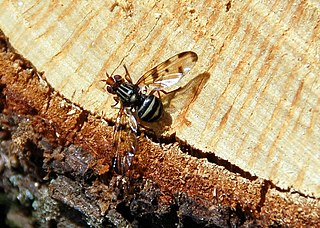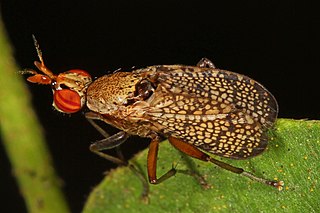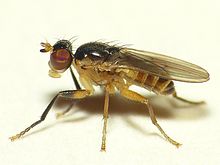
The family Sciomyzidae belongs to the typical flies (Brachycera) of the order Diptera. They are commonly called marsh flies, and in some cases snail-killing flies due to the food of their larvae.

The Ulidiidae or picture-winged flies are a large and diverse cosmopolitan family of flies (Diptera), and as in related families, most species are herbivorous or detritivorous. They are often known as picture-winged flies, along with members of other families in the superfamily Tephritoidea that have patterns of bands or spots on the wings. Some species share with the Tephritidae an unusual elongated posteroapical projection of the anal cell in the wing, but can be differentiated by the smoothly curving subcostal vein. Two species, Tetanops myopaeformis and Euxesta stigmatias, are agricultural pests.

The Micropezidae are a moderate-sized family of acalyptrate muscoid flies in the insect order Diptera, comprising about 500 species in about 50 genera and five subfamilies worldwide,. They are most diverse in tropical and subtropical habitats, especially in the Neotropical Region.

The Pyrgotidae are an unusual family of flies (Diptera), one of only two families of Cyclorrhapha that lack ocelli. Most species are "picture-winged", as is typical among the Tephritoidea, but unlike other tephritoids, they are endoparasitoids; the females pursue scarab beetles in flight, laying an egg on the beetle's back under the elytra where the beetle cannot reach it. The egg hatches and the fly larva enters the body cavity of the beetle, feeding and eventually killing the host before pupating. In the United States, some species of Pyrgota and Sphecomyiella can be quite common in areas where their host beetles are abundant. Like their host beetles, these flies are primarily nocturnal, and are often attracted to artificial lights.

The Helosciomyzidae are a small family of flies found exclusively in the Southern Hemisphere. With the exception of the South American genus Sciogriphoneura, helosciomyzids occur only in Australia and New Zealand.

Otitinae is the name of a subfamily of flies in the family Ulidiidae. It was formerly the Otitidae. Like the Ulidiinae, most species are herbivorous or saprophagous. Most species share with the Tephritidae an unusual elongated projection of the anal cell in the wing, but can be differentiated by the smoothly curving subcostal vein. Most are dull gray to shiny brown or black flies with vein R1 setulose or, in a few cases, bare.

Platystomatinae is a subfamily of flies (Diptera) in the family Platystomatidae that includes 80 genera, the largest subfamily with at last estimate, c. 900 species globally.

Pherbellia is a genus of flies in the family Sciomyzidae, the marsh flies or snail-killing flies. They occur throughout the world, except for the Subantarctic region.

Sepedon is a genus of flies in the family Sciomyzidae, the marsh flies or snail-killing flies.

Limnia is a genus of flies in the family Sciomyzidae, the marsh flies or snail-killing flies.

Tetanocerini is a tribe of flies in the family Sciomyzidae. There are more than 400 described species in the tribe.

Tetanocera is a genus of marsh flies, insects in the family Sciomyzidae. There are at least 50 described species in Tetanocera.

Myennidini is a tribe of picture-winged flies in the family Ulidiidae.

Ephydrinae is a subfamily of shore flies in the family Ephydridae.
Hyadina is a genus of shore flies in the family Ephydridae.
Eutrichomelina is a genus of flies in the family Sciomyzidae, the marsh flies or snail-killing flies.
Protodictya is a genus of flies in the family Sciomyzidae, the marsh flies or snail-killing flies.
Sepedonea is a genus of flies in the family Sciomyzidae, the marsh flies or snail-killing flies.

Sciomyzini is a tribe of flies in the family Sciomyzidae.















